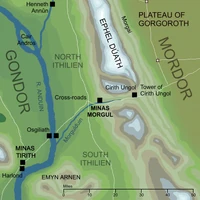- "A long-tilted valley, a deep gulf of shadow, ran back far into the mountains. Upon the further side, some way within the valley's arms, high on a rocky seat upon the black knees of the Ephel Dúath, stood the walls and towers of Minas Morgul. All was dark about it, earth and sky, but it was lit with light. Not the imprisoned moonlight welling through the marble walls of Minas Ithil long ago, Tower of the Moon, fair and radiant in the hollow of the hills. Paler indeed than the moon ailing in some slow eclipse was the light of it now, wavering and blowing like a noisome exhalation of decay, a corpse-light, a light that illuminated nothing."
- —The Two Towers, "The Stairs of Cirith Ungol"
Minas Morgul (meaning "Tower of Dark sorcery") was a City/Fortress of Gondor, originally called Minas Ithil ("Tower of the Rising Moon"). As the easternmost fortification in the kingdom of Gondor, and a sister city to Minas Anor (now known as Minas Tirith), Minas Ithil safeguarded the eastern borders of the Kingdom of Gondor and protected the capital Osgiliath from the forces of Mordor during the early part of the Third Age. As Gondor's armies weakened, it was then taken by the forces of Mordor, and used as a base to attack Gondor and in the process, decayed into the dark and demonic fortress that gave the city its new name.
Minas Morgul was located in an upland valley at the feet of the Mountains of Shadow. It overlooked the region of Ithilien and controlled the only easily accessible pass through the mountains that led into Mordor, the pass of Cirith Ungol.[1]
History
Minas Ithil

Minas Morgul located on this map
Minas Ithil was founded in the Second Age by the Númenorean, Isildur as a fortress city to defend Gondor from Sauron in Mordor. Isildur made his home in Minas Ithil, while Isildur's young brother Anárion dwelled across the Anduin in Minas Anor. In front of his house, Isildur planted a sapling of the White Tree, which he had rescued from the Downfall of Númenor, and in the tower was kept one of the Palantíri called the Ithil-stone.
In its heyday, Minas Ithil was described as a beautiful sight, with moonlight filling its inner courts with silver light and causing its walls to gleam silver and white. It was a walled city of white marble built on a high shelf of rock. Within the walls, there were white houses and a tall tower. The walls and the tower had many windows, and the top of the tower revolved slowly back and forth. A road ran from Osgiliath on the Anduin through Ithilien to the city and crossed the Mountains of Shadow into Mordor via the pass.
In SA 3428, Sauron sent a huge army to Minas Ithil and after about a year of siege, it was captured and the White Tree was burned (Isildur recovered a sapling and planted it in Minas Anor in TA 2). However, in SA 3430, Anárion recaptured the city, preventing Minas Ithil from being turned into an early Minas Morgul.
After Sauron was defeated in the War of the Last Alliance in SA 3441, a watch was kept from Minas Ithil to prevent the return of evil to Mordor.

The Witch-King in his throne of Angmar.
The Nazgûl, led by the Witch-king of Angmar, the most fearsome of Sauron's minions, returned to Mordor in 1980 to prepare for Sauron's return. Meanwhile, Gondor had been devastated by many attacks of Mordor's allies, the Wainriders, Variags, and Haradrim, who gained two devastating victories, killed two kings, and conquered almost all the provinces east of the Anduin. Soon Mordor started to attack and conquer parts of Gondor. In TA 2000, the forces of the nine Nazgûl laid siege to Minas Ithil. In TA 2002 after a long siege, the city fell and was transformed into a bastion of evil. As a result, it came to be called Minas Morgul, which in Sindarin means Tower of Dark Sorcery. Minas Morgul stood upon the Morgulduin, a polluted tributary of the Anduin.
The Palantír's (Ithil-stone's) fate was unknown. Many Men of Gondor believed the guards of the city had destroyed it, but by the nature of the Palantíri, this was impossible. Others believed that it was taken to Barad-dûr, which became known as the real seat of power in Mordor.
Minas Morgul

The Witch-king's true look, as seen in the The Fellowship of the Ring film
Terror and war were directed at Gondor from Minas Morgul until Ithilien was deserted. During the War of the Ring, the army that attacked Osgiliath and undertook the Siege of Gondor came from Minas Morgul.
In fashion Minas Morgul seems to have been much like Minas Tirith, only corrupted. The topmost course of the tower revolved slowly, and the walls were illuminated by a pale luminous glow. Under a white bridge flowed the foulest river in Middle-earth, the Morgulduin.
The city had a strange watchfulness about it, and intruders to Morgul Vale were always noted. Most who approached the city could not stand to set eyes on it, and felt that they were being watched.
During the War of the Ring, Aragorn and Gandalf break the bridge and set the fields by it on fire to keep the Minas Morgul troops from the Crossroads.
After the War of the Ring, King Elessar (Aragorn) counseled Faramir to make his abode in the Emyn Arnen southeast of Minas Tirith, in Ithilien, and decreed that Minas Ithil in the Morgul Vale, despoiled by its years as Minas Morgul, be completely destroyed, for although it might in time come to be made clean, no man might dwell there for many long years[2]. Eventually, the city was rebuilt as Minas Ithil and the evil that tainted the land was at last gone.
Etymology
The name Minas Morgul is comprised of the Sindarin terms minas ("tower") and morgul ("sorcery"). Morgul can also mean "black sorcery", from mor ("black").
Its previous name, Minas Ithil, means "Tower of the Rising Moon", from the Vanyarin isil, meaning moon, or the Sindarin ithil.
Rulers of Minas Morgul
- Witch-king of Morgul: Better known as the Witch-king of Angmar, was the leader of the Nazgûl and the principal ruler of Minas Morgul.
Portrayal in adaptations
The Lord of the Rings film trilogy
In Peter Jackson's movie adaptation of The Lord of the Rings: The Return of the King, Minas Morgul is shown as a massive spectral fortress on the other side of a moat. Frodo is drawn by the power of the Ring, but Sam and Gollum hide him as the Morgul army of orcs passes; the Nazgûl on their mounts are not seen, except for the Witch-king who is shown to leave the fortress on a Fellbeast. It also makes a brief appearance in the first film, The Fellowship of the Ring, when the Ringwraiths (mounted on horses) are shown exiting the fortress en route to the Shire far away.
Middle-earth: Shadow of War video game
The video game Middle-earth: Shadow of War features Minas Ithil throughout the game, and depicts its transformation into Minas Morgul after being besieged by the Nazgûl and an army of Uruk-hai. In the game, the main character, Talion, aided by the wraith of the Elf-smith Celebrimbor, attempts to hold back the siege only to be betrayed from within. The city falls into the hands of Sauron and becomes Minas Morgul.
Translations around the World
| Foreign Language | Translated name |
|---|---|
| Amharic | ሚናስ ሞርጉል |
| Arabic | ميناس مورعول |
| Armenian | Մինաս Մորգուլ |
| Belarusian Cyrillic | Мі́нас Мо́ргул |
| Bengali | মিনাস মর্গুল্ |
| Bulgarian Cyrillic | Минас Моргул |
| Catalan | Minas Mórgul |
| Chinese (Hong Kong) | 米那斯魔窟 |
| Dari | میناس مورگول |
| Georgian | მინას მორგულ |
| German | Minas Morgul |
| Greek | Μήνας Μόργγουλ |
| Gujarati | મિનસ મોર્ગુલ્ |
| Hebrew | מינאס מורגול |
| Hindi | मिनस मोर्गुल् |
| Italian | Minas Morgul |
| Japanese | ミナス・モルグル |
| Kannada | ಮೈನಸ್ ಮಾರ್ಗುಲ್ |
| Kazakh Cyrillic | Мінас Моргұл |
| Korean | 미나스 모르굴 |
| Kurdish | میناس مۆرگول (Arabic script) Minas Morgol (Latin) |
| Kyrgyz Cyrillic | Минас Моргул |
| Lao | ມິນະຊ ມໂrgຸຣ ? |
| Macedonian Cyrillic | Минас Моргул |
| Mongolian Cyrillic | Минас Моргул |
| Nepalese | मिनस मोर्गुल् |
| Pashto | میناس مورګول |
| Persian | میناس مورگول |
| Russian | Минас Итиль |
| Sanskrit | मिनस् मोर्गुल् |
| Serbian | Минас Моргул (Cyrillic) Minas Morgul (Latin) |
| Sinhalese | මිනස් මොර්ගුල් |
| Tajik Cyrillic | Минас Моргул |
| Tamil | மிநஸ் மொர்குல் |
| Telugu | మినస మొర్గుల్ |
| Thai | มินัสมอร์กูล |
| Tibetan | མིནས མོརྒུལ |
| Tigrinya | ሚናስ ሞርጉል |
| Ukrainian Cyrillic | Мінас Морґул |
| Urdu | میناس مورگول |
| Uzbek | Минас Моргул (Cyrillic) Minas Morgul (Latinised) |
| Uyghur | مىناس مورگۇل |
| Yiddish | מינאַס מאָרגול |
| Turkish | Minas Morgul |
References
- ↑ The Atlas of Middle-earth, Regional Maps, "Mordor (and Adjacent Lands)"
- ↑ The Lord of the Rings, The Return of the King, Book Six, Chapter V: "The Steward and the King"
